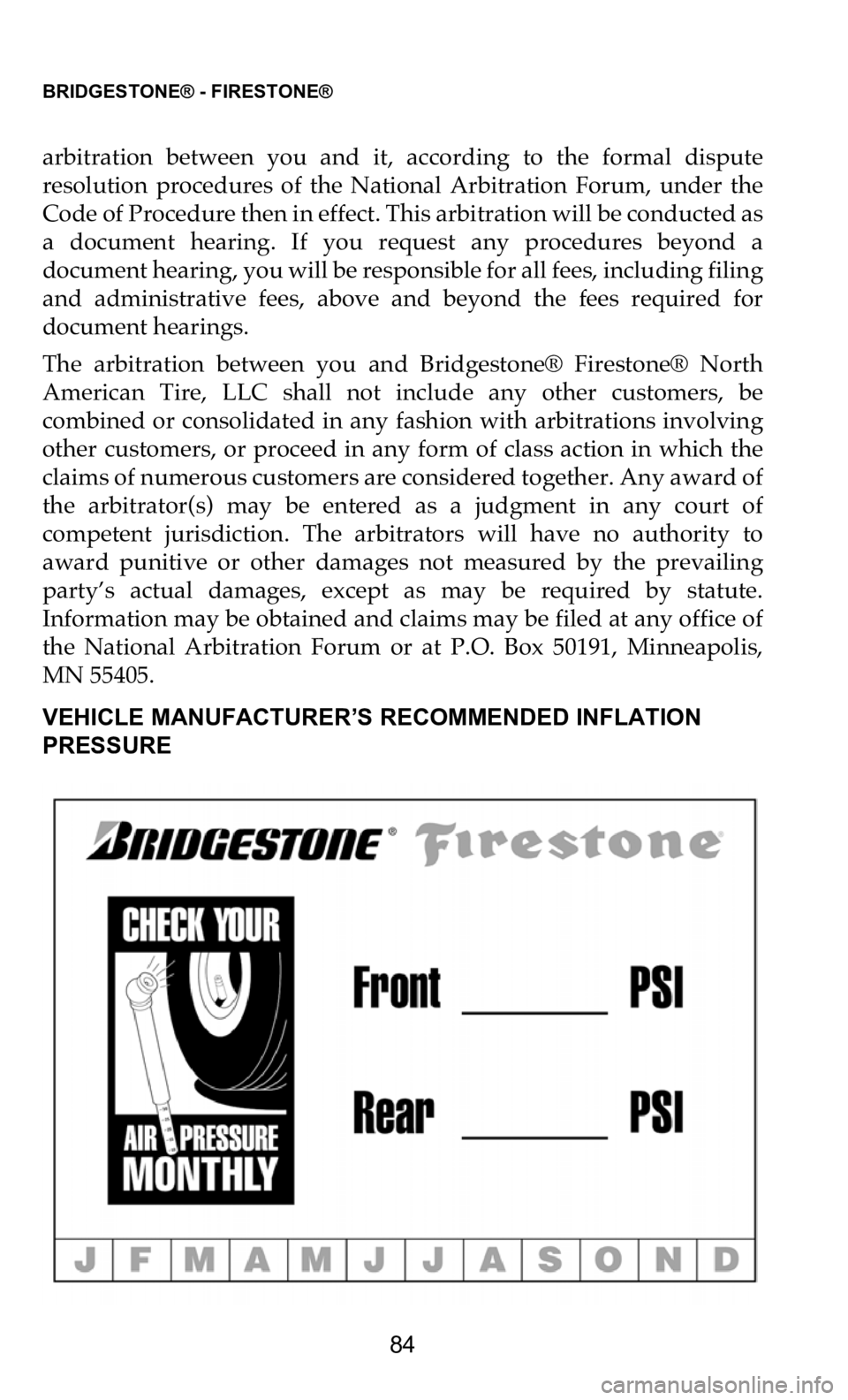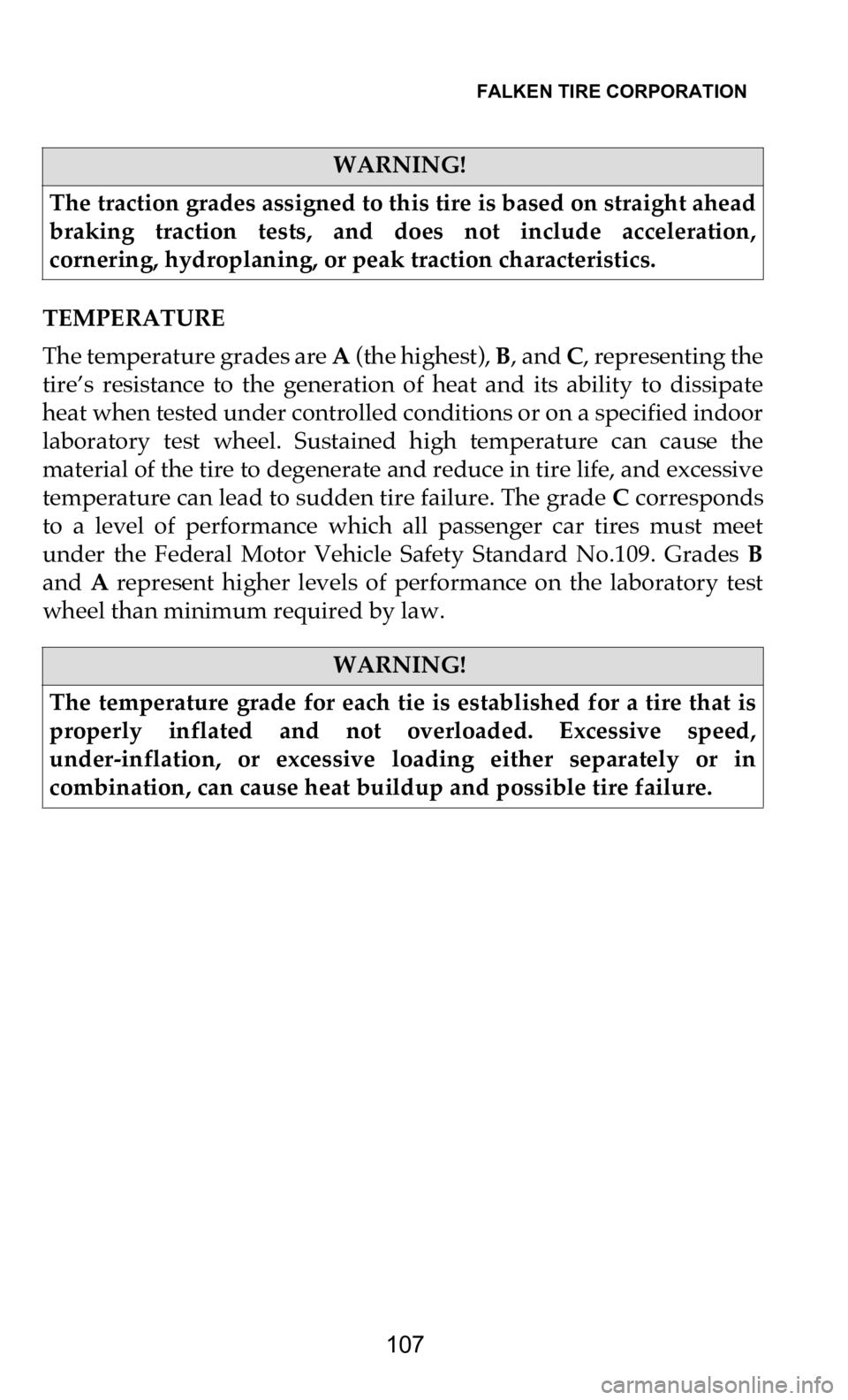ESP DODGE DURANGO 2021 Vehicle Warranty
[x] Cancel search | Manufacturer: DODGE, Model Year: 2021, Model line: DURANGO, Model: DODGE DURANGO 2021Pages: 262, PDF Size: 10.42 MB
Page 63 of 262

BRIDGESTONE® - FIRESTONE®
62
TIRE MOUNTING AND OTHER SERVICING
This manual is not intended to provide proper training or service
pr
ocedures for tire mounting, demounting, balancing, rotation, or
repair. Please leave these tasks to qualified tire service
professionals. For your safety and that of others:
• Always stand well clear of any tire mounting operation. This is espe -
c
ially important when the service operator inflates the tire. If the tire
ha
s been improperly mounted, it may burst with explosive force
causing serious personal injury or death.
• Tires must match the width and diameter requirements of the
w
heels. For example, 16 inch diameter tires must only be mounted
to
16 inch diameter wheels. Radial tires must only be mounted to
wh
eels approved for radial tires.
• Wheels must be free of cracks, dents, chips, and rust. Tires must be
f
ree of bead damage, cuts, and punctures.
• Never inflate a tire beyond 40 psi (275 kPa) to seat the beads. Be
a
bsolutely certain beads are fully seated before adjusting inflation
pressure to the level recommended for vehicle operation.
• Never put flammable substances in tire/wheel assemblies at any
t
ime. Never put any flammable substance into a tire/wheel
assembly and attempt to ignite to seat the beads.
• Always stand well away from the work area when tires are being
s
pin balanced either on or off the vehicle.
WARNING!
Removing and replacing tires on wheels can be dangerous.
At
tempting to mount tires with improper tools or procedures may
result in a tire explosion causing serious personal injury or death.
This is only a job for a qualified tire service professional. Never
perform tire service procedures without proper training, tools,
and equipment.
Page 64 of 262

BRIDGESTONE® - FIRESTONE®
63
HIGH PERFORMANCE, LOW ASPECT RATIO TIRES
Many new vehicles come equipped from the factory with high
pe
rformance and/or low aspect ratio tires. Generally, these tires
provide increased vehicle handling capability, but may also have
numerous engineering performance trade-offs associated with their
designs.
• Low aspect ratio tires, with reduced sidewall height, may be more
s
usceptible to damage from potholes, road hazards, and other
objects such as curbs. This is true for the wheels as well. Therefore,
as with all other tires, it is important to drive with care and maintain
proper inflation pressure and load conditions. See “Tire Inflation
Pressure” and “Tire Damage, Inspection and Service Life” in this
manual.
• Some sports cars and other handling performance enhanced vehi -
c
les, including sedans and light trucks/SUVs, may be originally
eq
uipped with high performance tires that are more optimized for
warmer weather use. Colder, winter weather traction may be
reduced for these types of tires. Winter tires may be recommended
by the vehicle manufacturer for colder weather application. See
“Winter Tires,” the next section in this manual.
• High performance tires may also wear more quickly, ride more
f
irmly, and produce more noise during operation.
Consult your vehicle Owner’s Manual and tire information placard, or
a
qualified tire service professional, for more information and
specifics regarding these types of tires.
WINTER TIRES
In Winter driving conditions, vehicle control and safe operation under
b r
aking and cornering is especially dependent upon the rear tires. For
this reason, Winter tires are best applied to all wheel positions. Some
WARNING!
Winter driving presents special challenges for vehicle mobility.
Th
e use of winter tires (including studs and chains)—while
improving traction performance in snow and ice—requires special
care with regard to acceleration, braking, cornering, and speed. It
is important to drive with care, not only on snow and ice, but on
dry and wet roads as well.
Page 80 of 262

BRIDGESTONE® - FIRESTONE®
79
Temperature
The temperature grades are A (the highest), B, and C, representing the
ti
re’s resistance to the generation of heat and its ability to dissipate
heat when tested under controlled conditions on a specified indoor
laboratory test wheel. Sustained high temperature can cause the
material of the tire to degenerate and reduce tire life, and excessive
temperature can lead to sudden tire failure. The grade C corresponds
to a level of performance which all passenger car tires must meet
under the Federal Motor Vehicle Safety Standard No.109. Grades B
and A represent higher levels of performance on the laboratory test
wheel than the minimum required by law.
WARNING!
The temperature grade is established for a tire that is properly
in
flated and not overloaded. Excessive speed, underinflation, or
excessive loading, either separately or in combination, can cause
heat buildup and a possible tire failure.
Page 85 of 262

BRIDGESTONE® - FIRESTONE®
84
arbitration between you and it, according to the formal dispute
resolution procedures of the National Arbitration Forum, under the
Code of Procedure then in effect. This arbitration will be conducted as
a document hearing. If you request any procedures beyond a
document hearing, you will be responsible for all fees, including filing
and administrative fees, above and beyond the fees required for
document hearings.
The arbitration between you and Bridgestone® Firestone® North
Am
erican Tire, LLC shall not include any other customers, be
combined or consolidated in any fashion with arbitrations involving
other customers, or proceed in any form of class action in which the
claims of numerous customers are considered together. Any award of
the arbitrator(s) may be entered as a judgment in any court of
competent jurisdiction. The arbitrators will have no authority to
award punitive or other damages not measured by the prevailing
party’s actual damages, except as may be required by statute.
Information may be obtained and claims may be filed at any office of
the National Arbitration Forum or at P.O. Box 50191, Minneapolis,
MN 55405.
VEHICLE MANUFACTURER’S RECOMMENDED INFLATION
P R
ESSURE
Page 91 of 262

CONTINENTAL TIRE
90
Owner must present new vehicle registration form or new vehicle
sales invoice indicating the date of purchase. Owner will be re -
quired to sign the CTA Limited Warranty Claim Form or dealer re -
placement sales receipt.
Owner is responsible for paying all applicable taxes charged by the
se
rvicing dealer and is also responsible for paying shipping, local
tire-disposal fees and parts or service regardless of mileage or
months of service. This includes payment for tire rotation, align -
ment, towing, road service, valve stems and tire repairs.
Owner is responsible for maintaining proper tire air pressure and
fo
r proper maintenance of the tire.
6. SAFETY WARNING:
I
gnoring any of the safety and information contained in this war -
ranty may result in tire failure, causing serious injury or death.
• Tire failure due to under inflation/overloading. Follow vehicle
o
wner’s manual or tire placard in vehicle for proper inflation and
loading.
• Explosion of tire/rim assembly due to improper tire mounting.
T
ire mounting / demounting can be dangerous. It should be
performed only by a trained tire specialist using proper tools and
procedures. Prior to tire mounting/demounting, the Rubber
Manufacturers Association (RMA) wall charts and manuals
should be read to obtain the proper procedures. The failure to
follow these procedures may result in faulty positioning of the
tire and/or rim, which may cause the assembly to burst with
force sufficient to cause injury or death.
• Tire failure due to damage.
Inspect your tires frequently for
scrapes, bulges, separations, cuts, snags and other damage from
road hazards. Damage from impact can occur to the inner
portions of your tire without being visible to the outside. If you
suspect a tire has been damaged from striking anything unusual
in the road, you must have the tire removed from the rim and
inspected both inside and out by a trained tire specialist. Air loss
or unusual tire wear can also be warning signs that a tire may
have internal damage. If you notice these conditions, have your
tire inspected by a trained individual.
• Tire failure due to excessive tire spinning.
Avoid tire spinning.
The centrifugal force generated by a free-spinning tire/rim
assembly may cause a sudden tire explosion resulting in vehicle
Page 103 of 262

FALKEN TIRE CORPORATION
102
2. WHAT IS NOT COVERED BY THE WARRANTY
• Tires that becomes unserviceable due to road hazard damages
(
cuts, snags, punctures, bruises, impact breaks, etc.) improper
repair technique or materials, improper inflation, overload,
irregular wear, wheel imbalance, defective mechanical vehicle
components (brakes, suspension, wheels, etc.) improper suspen -
sion alignment, accident, fire, chemical damage, damage from
ch
ain use, racing, off-road use, run flat, improper installation,
vandalism, or abuse.
• Tires branded “NA” or a tire in which the DOT numbering has
b
een removed.
• Tires presented for a warranty claim by someone other than by
t
he original purchaser, or tires that were transferred to another
vehicle from the vehicle in which the tires were originally
installed.
• Tires having a failure or failures caused by a previous damages
o
r repairs.
• The cost of tire repair or retreading is not covered by this
w
arranty and will be the sole responsibility of the tire owner.
Possible NON Covered Reasons/Conditions due to:
Chipping/Chunking/Tearing Puncture
Corrosion/Wreck Racing or any Competition
Fire Repair Failure
Impact Break or Concussions Road Hazards
Improper Inflation Pressure Sidewall Cut or Damage
Improper Mounting/Dismount Theft or Vandalism
Mechanical Defects of the Vehicle Tread Cuts
Misalignment Wheel Imbalance
Misapplication Willful Abuse
Overloading
Page 104 of 262

FALKEN TIRE CORPORATION
103
3. OWNER’S OBLIGATIONS
At least monthly, the vehicle owner(s) should check the tires’ air
pr
essure with a gauge and inflate to the recommended cold air
pressure level listed on the driver door placard. Do not rely on car
servicers to perform the checks. The tires should be rotated at least
every 8,000km (5,000 miles) or earlier if uneven wear is occurring,
an
d proof of maintenance records should be kept. The owner(s)
should have the tires rebalanced if vibration is experienced, and the
vehicle’s alignment should be checked if uneven or rapid wear is
occurring, or when suggested by the vehicle’s manufacturer.
All warranty claims must be presented to an authorized Falken
de
aler or participating car dealership. The owner(s) must present
any supporting maintenance records and documentation neces -
sary to help determine if the tire(s) in question are deemed covered
by
the limited warranty or not.
4. LEGAL RIGHTS A
ll implied warranties, including warranties of merchantability
an
d fitness for a particular purpose shall be limited in duration to
the above period. To the extent permitted by law, Falken Tire Cor -
poration shall not be responsible for incidental or consequential
da
mages, such as loss of use of the tire or the vehicle on which it is
used, inconvenience, or commercial loss, some states do not allow
limitations on how long an implied warranty lasts, or the exclusion
or limitation of incidental or consequential damages, so the above
limitations or exclusions may not apply to you. This warranty gives
you specific legal rights and you may also have other rights, which
vary from state to state. This is the only express warranty applica -
ble to Falken brand tires and supersedes the terms of any previous
wa
rranty. Falken neither assumes nor authorizes anyone to make
or assume for it any other warranty.
C) UNDERSTANDING YOUR TIRES
TIRE SPEED SYMBOLS
Tires that are speed-rated are identified by the following letter
sy
mbols: Q, S, T, U, H, V, W, Y, (Y), or (ZR). The Speed Rating’s
Symbol can be found as a part of the tire size designation (ex: 215/
65HR16) or after the load index immediately following the tire size
designation (ex: 215/65R16 97H). The Speed Rating’s Symbol
indicates the maximum speed that a tire can handle when properly
inflated and loaded.
Page 108 of 262

FALKEN TIRE CORPORATION
107
TEMPERATURE
The temperature grades are A
(the highest), B, and C, representing the
tire’s resistance to the generation of heat and its ability to dissipate
heat when tested under controlled conditions or on a specified indoor
laboratory test wheel. Sustained high temperature can cause the
material of the tire to degenerate and reduce in tire life, and excessive
temperature can lead to sudden tire failure. The grade C corresponds
to a level of performance which all passenger car tires must meet
under the Federal Motor Vehicle Safety Standard No.109. Grades B
and A represent higher levels of performance on the laboratory test
wheel than minimum required by law.
WARNING!
The traction grades assigned to this tire is based on straight ahead
br
aking traction tests, and does not include acceleration,
cornering, hydroplaning, or peak traction characteristics.
WARNING!
The temperature grade for each tie is established for a tire that is
pr
operly inflated and not overloaded. Excessive speed,
under-inflation, or excessive loading either separately or in
combination, can cause heat buildup and possible tire failure.
Page 118 of 262

GENERAL TIRE
117
IN OBSERVANCE OF U.S. FEDERAL LAW, THIS LIMITED
WARRANTY AND ADJUSTMENT POLICY HAS BEEN
DESIGNATED A “LIMITED WARRANTY”. CTNA DOES NOT
INTEND TO REPRESENT THROUGH THIS LIMITED
WARRANTY AND ADJUSTMENT POLICY THAT TIRE
FAILURES CAN OR CANNOT HAPPEN.
CONTINENTAL TIRE NORTH AMERICA’S (CTNA) OBLIGATIONS
Contact the vehicle dealer from where you purchased the vehicle.
Yo
ur tires may be covered under the vehicle manufacturer’s limited
warranty. If not, this CTNA Policy applies and replacement of Eligible
Tires can be made by any vehicle dealer authorized to handle General
brand tire adjustments or a General brand authorized dealer
(“Authorized Dealer”). CTNA will replace the tire pursuant to the
terms of this Limited Warranty and Adjustment Policy. Tires that are
replaced under an adjustment basis under this Limited Warranty and
Adjustment Policy become the property of CTNA.
OWNER’S OBLIGATIONS
To make an eligible claim under this Limited Warranty and Adjustment
Po
licy, the owner must present a claim with the tire to an authorized
dealer. For the nearest authorized dealer, consult the Yellow Pages, the
General brand internet address, or the 800 telephone numbers shown
on the back of this Limited Warranty and Adjustment Policy. Owner
must present new vehicle registration form or new vehicle sales invoice
indicating the date of purchase. Owner will be required to sign the
CTNA Limited Warranty Claim Form or dealer replacement sales
receipt.
Owner is responsible for paying all applicable taxes set forth under
th
is Limited Warranty and Adjustment Policy. Owner is also
responsible for paying local tire disposal fees and any parts or service
regardless of mileage or months of service. This includes payment for
tire rotation, alignment, towing, road service, valve stems and tire
repairs. Owner is responsible for maintaining proper tire air pressure
and for proper maintenance of the tire.
Page 128 of 262

GOODYEAR® DUNLOP® TIRES
127
DO NOT SPIN YOUR TIRES EXCESSIVELY
Avoid excessive tire spinning when your vehicle is stuck in snow, ice,
mu
d or sand. The centrifugal forces generated by a free-spinning tire/
wheel assembly may cause sudden tire explosion, resulting in vehicle
damage and/or serious personal injury to you or a bystander. Never
exceed 35 mph (55 km/h), as indicated on your speedometer. Use a
ge
ntle backward and forward rocking motion to free your vehicle for
continued driving. Never stand near or behind a tire spinning at high
speeds, for example, while attempting to push a vehicle that is stuck
or when an on-the-car spin balance machine is in use.
DO CHECK YOUR TIRES FOR WEAR
Always remove tires from service when they reach two thirty-seconds
of
an inch (2/32") remaining tread depth. All new tires have tread
wear indicators which appear as smooth banks in the tread grooves
when they wear to the two thirty seconds of an inch (2/32") level.
Many wet weather accidents result from skidding on bald or nearly
bald tires. Excessively worn tires are also more susceptible to
penetrations.
DO CHECK YOUR TIRES FOR DAMAGE
Frequent (at least monthly) inspection of your tires for signs of
da
mage and their general condition is important for safety. If you
have any questions, have your tire dealer inspect them. Impacts,
penetrations, cracks, knots, bulges or air loss always require tire
removal and expert inspection. Never perform a temporary repair or
use an inner tube as a substitute for a proper repair. Only qualified
persons should repair tires.
PROPER TIRE REPAIR
Goodyear® does not warrant any inspection or repair process. The
re
pair is entirely the responsibility of the repairer and should be made
in accordance with established Rubber Manufacturers Association
(RMA) procedures.
Tire Pressure Monitoring System (TPMS) Alert
Refer to your vehicle Owner’s Manual for more information on what
to
do if the Tire Pressure Monitoring System (TPMS) alert activates.